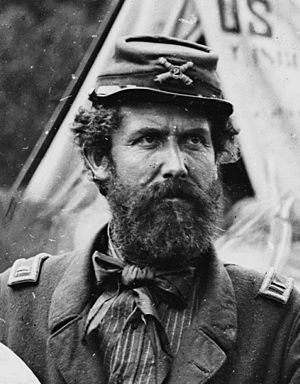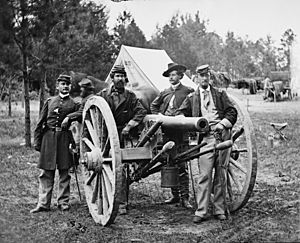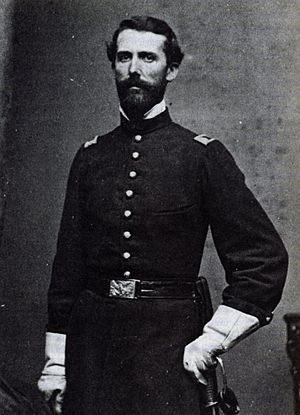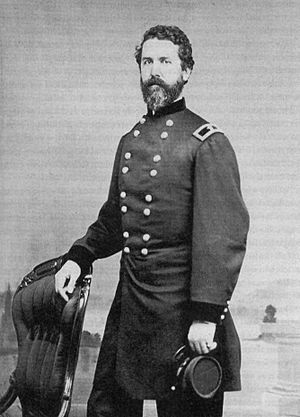John C. Tidball facts for kids
Quick facts for kids
John Caldwell Tidball
|
|
|---|---|
 |
|
| 3rd Commander of the Department of Alaska | |
| In office September 23, 1870 – September 19, 1871 |
|
| President | Ulysses S. Grant |
| Preceded by | George K. Brady |
| Succeeded by | Harvey A. Allen |
| Personal details | |
| Born | January 25, 1825 near Wheeling, Virginia (present-day West Virginia) |
| Died | May 17, 1906 (aged 81) Montclair, New Jersey |
| Resting place | West Point Cemetery West Point, New York. USA |
| Military service | |
| Allegiance | |
| Branch/service | Union Army |
| Years of service | 1848–1889 |
| Rank | |
| Unit | 2nd U.S. Artillery 4th New York Heavy Artillery 3rd U.S. Artillery 1st U.S. Artillery |
| Battles/wars | Third Seminole War American Civil War |
John Caldwell Tidball (January 25, 1825 – May 15, 1906) was a career United States Army artillery officer who served in the United States Horse Artillery Brigade in the Union Army of the Potomac during the American Civil War. After the war, he served as the Commander of the Department of Alaska, the military governor of the region.
Contents
Early life and antebellum career
Tidball was born near Wheeling, Virginia in Ohio County, Virginia (present-day West Virginia), to parents: James Squires Tidball and Maria Caldwell. He grew up on a farm in eastern Ohio. He graduated eleventh of thirty-eight cadets in the United States Military Academy Class of 1848, and entered the United States Army as a brevet second lieutenant in Battery E, 3rd U.S. Artillery. He was commissioned second lieutenant on February 14, 1849, when he was transferred to Battery M, 2nd U.S. Artillery. Promoted to first lieutenant on March 31, 1853, he transferred again to Battery B, 2nd U.S. Artillery. He served in the Third Seminole War fought against the indigenous Seminole tribe, and accompanied an exploring expedition to California in 1853–1854. In 1859 he was sent on the Army's expedition to Harper's Ferry, Virginia to suppress John Brown's raid.
Civil War
Tidball served all through the Civil War, receiving five brevet commissions for gallant and meritorious conduct on the field, and being complimented personally by President Abraham Lincoln for his work at the Battle of Gettysburg, where he was in command of the Second Brigade Horse Artillery under Major General Alfred Pleasonton. He served in most of the major campaigns in the Eastern Theater, from the First Battle of Bull Run through the Siege of Petersburg.
At the outbreak of hostilities, he ranked as a first lieutenant and section chief in Captain William F. Barry's Battery A, 2nd U.S. Artillery. After Barry's promotion, on May 14, 1861, Tidball was promoted to captain and became the company commander. Tidball served with his "flying" battery as part of the famed U.S. Horse Artillery Brigade from its inception in 1861 until June 1863. In 1862, he was credited with introducing the custom of sounding "Taps" to conclude a military funeral.
With slow advancement in the ranks of the Regular Army (United States) (especially in the artillery branch), Tidball sought higher responsibilities elsewhere, by accepting a commission in the U.S. Volunteers. He was appointed colonel of the 4th New York Heavy Artillery Regiment, August 28, 1863. He commanded Brigade 4 of the Defenses South of the Potomac XXII Corps (Union Army), September 2, 1863–November 5, 1863, transferring to the command of Brigade 3, November 5, 1863 to March 26, 1864.
Tidball commanded the artillery of the II Corps of the Army of the Potomac during the Overland Campaign, including the Battle of the Wilderness, April 1864–July 6, 1864. He was commandant of cadets at West Point from July 10, 1864 to September 22, 1864. He then returned to the field, leading the artillery of the IX Corps from October 8, 1864 until April 24, 1865 in the Appomattox Campaign and April 24, 1865–June 30, 1865 in the Department of Washington. He then resumed command of Brigade 3, of the Defenses South of the Potomac XXII Corps (Union Army). Tidball was mustered out of the volunteers on September 26, 1865.
On December 12, 1864, President Abraham Lincoln nominated Tidball for appointment to the grade of brevet brigadier general of volunteers, to rank from August 1, 1864, and the United States Senate confirmed the appointment on February 20, 1865.
On July 17, 1866, President Andrew Johnson nominated Tidball for appointment to the grade of brevet brigadier general in the regular United States Army, to rank from March 13, 1865, and the United States Senate confirmed the appointment on July 23, 1866.
On January 13, 1866, President Andrew Johnson nominated Tidball for appointment to the grade of brevet major general of volunteers, to rank from April 2, 1865, and the United States Senate confirmed the appointment on March 12, 1866.
Wartime evaluations
To the frustration of all professionals within the Artillery branch, promotions were notoriously slow in comparison with the Infantry and Cavalry branches. Tidball commanded a brigade of horse artillery as a captain, fought in most of the major battles and campaigns of the war, and was frequently cited for efficiency, reliability and military professionalism. He was frequently discussed among the high command as a candidate well-deserving of promotion. But as was typical of his branch, he was just as frequently passed over. The following are some of the opinions expressed about him from his commanders, subordinate officers, and even some of his men, as found within Eugene Tidball's 2002 biography (No Disgrace to My Country):
John Haskell Calef, wrote of his first impressions as a second lieutenant, serving under Tidball in Battery A, 2nd U.S.
Hildreth later changed his tune, writing home again that:
Postbellum career
After being mustered out of the volunteers, Tidball reverted to his Regular Army grade of captain. He was promoted to major, February 5, 1867. He was in active service until his retirement on January 25, 1889. He was the 3rd Commander of the Department of Alaska (which preceded the position of Governor of Alaska), and lived there for six years. He was Commandant of Cadets at West Point in 1864, and was Commandant at the Artillery School at Fort Monroe in Virginia, reorganizing artillery instruction and raising its standards during his tenure. He was promoted to colonel and served as aide-de-camp to General William T. Sherman during the latter's tenure as general-in-chief of the U.S. Army, January 1, 1881–February 8, 1884. He was transferred to the 1st Regiment of Artillery, November 10, 1882, the 3rd U.S. Artillery, January 25, 1884 and the 1st Regiment of Artillery again, March 22, 1885.
When Tidball retired, he was regarded as the Army's premier artillerist. His 1880 instruction book, Manual Of Heavy Artillery Service, served for decades as the army's guidebook to artillery strategy and operations. Tidball was appointed brigadier general on the retired list, April 23, 1904.
Personal life
John C. Tidball married twice. His first wife, Mary Hunt Davis (d. 1857), was the daughter of Lieutenant Jackman Davis (d. 1828), USMA Class of 1814. The two were married May 27, 1853, and had three children together: Virginia (1855–1856), John Satterlee (b. 1856), and Walton Caldwell (1857–1896). Mary died of complications after Walton's birth, in 1857.
His second wife, Mary Langdon "Mamie" Dana (ca. 1845–1892), was the daughter of Major General Napoleon J. T. Dana. General Dana, only three years older than Tidball (and six ahead of him at West Point, graduating with the USMA Class of 1842), first opposed the match, given the 20 years difference in age and life experience, but eventually consented, due to Tidball's excellent reputation and the couple's obvious affection. John and Mamie were married March 19, 1870, and built a family of their own: Sue Dana (b. 1871), Alfred Dana (b. 1872), Nora Langdon (b. 1873), and twins Mabel and William (b. 1875).
He died on May 15, 1906 at the age of 81 in his residence in Montclair, New Jersey, and was buried in the post cemetery at the United States Military Academy in West Point, New York.
Writings and memoirs
John C. Tidball wrote a comprehensive overview and analysis of the U.S. Army's field artillery service in the Civil War in the Journal of the Military Service Institution from 1891 to 1893, entitled, "The Artillery Service in the War of the Rebellion." He also wrote an unpublished study in 1905 for the U.S. Army entitled, "Remarks Upon the Organization, Command and Employment of Field Artillery During War, Based on Experiences of the Civil War, 1861–1865", which included additional insights into the artillery service. These writings were edited by Lawrence M. Kaplan and published under the title, "The Artillery Service in the War of the Rebellion" by Westholme Publishing in 2011. John C. Tidball's memoirs, yet unpublished but heavily excerpted in Eugene Tidball's 2002 biography, are a treasure trove of information. They are filled with colorful descriptions and his impressions of his more famous contemporaries, many of whom he described as "genuine army characters." Through these writings, one can learn a great deal about John C. Tidball, along with the personalities he so brilliantly described:
Ambrose E. Burnside
Tidball served with Burnside at his first duty station after graduation from West Point.
Thomas Jonathan Jackson
Tidball and Jackson were assigned to the same company in the Corps of Cadets at West Point.
Robert E. Lee
Tidball found himself among future Confederate heroes Robert E. Lee and J. E. B. Stuart during the suppression of John Brown's raid, in October 1859.
John B. Magruder
William Tecumseh Sherman
Tidball served as one of Sherman's aides-de-camp during Sherman's postwar term as general-in-chief of the U.S. Army.
George H. Thomas
Tidball met Thomas during the early days of his career.
Dates of Rank
- Cadet, U.S. Military Academy, July 1, 1844
- Graduate (11th in the Class), U.S. Military Academy, July 1, 1848
- Brevet Second Lieutenant, U.S. Army, July 1, 1848
- Assigned to Battery E, 3rd U.S. Artillery
- Commissioned Second Lieutenant, U.S. Army, February 14, 1849
- Assigned to Battery M, 2nd U.S. Artillery
- First Lieutenant, Battery B, 2nd U.S. Artillery, March 31, 1853
- Captain, Battery A, 2nd U.S. Artillery, May 14, 1861
- Brevet Major, U.S. Army, June 27, 1862, for gallant and meritorious service during the battle of Gaines Mill
- Brevet Lieutenant Colonel, U.S. Army, September 17, 1862, for gallantry and meritorious service during the battle of Antietam
- Colonel, 4th New York Artillery (U.S. Volunteers), August 28, 1863
- Brevet Brigadier General, U.S. Volunteers, August 1, 1864, for gallantry and meritorious service during the battles of Po (at the Po River), Spotsylvania Court House, and Petersburg
- Brevet Colonel, U.S. Army, March 13, 1865, for gallantry and meritorious service during the battle of Fort Stedman
- Brevet Brigadier General, U.S. Army, March 13, 1865, for gallantry and meritorious service in the field during the Rebellion
- Brevet Major General, U.S. Volunteers, April 2, 1865, for gallantry and meritorious service during the battles of Ft. Stedman and Ft. Sedgwick
- Mustered out of U.S. Volunteers, September 26, 1865
- Major, 2nd U.S. Artillery, February 5, 1867
- Colonel of Staff, January 1, 1881 – February 8, 1884, while serving as aide-de-camp to General William T. Sherman
- Lieutenant Colonel, 3rd U.S. Artillery, June 30, 1882
- Colonel, 1st U.S. Artillery, March 2, 1885
- Retired, January 25, 1889
See also
- List of American Civil War brevet generals (Union)
- Fort Randolph (Panama) (battery Tidball is named after him).
- Fort Tidball named after General John C. Tidball Kodiak Island, Alaska




